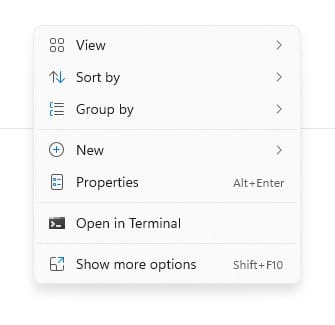If you want speed, control, and automation, use CLI. If you want ease, visibility, and intuitive controls, go with GUI. The choice isn’t about which is “better.” It’s about using the right tool for the right job.
Command-Line Interface (CLI) and Graphical User Interface (GUI) are the two core ways we interact with computers. They’re not competing rivals… they’re tools with different strengths.
CLI
A Command-Line Interface (CLI) lets users type text commands to perform specific tasks. It’s like talking directly to your system in its own language.
Example:
mkdir new-folder
This one-line command creates a new folder. No clicks, no windows—just direct execution.
CLIs are typically used in:
- Terminal or shell (e.g., Bash, Zsh)
- Developer consoles
- Automation scripts
- System administration
GUI
A Graphical User Interface (GUI) uses icons, buttons, and visual menus that you can click and drag. Everything is navigable by mouse or touch, no code needed.
Example: To create a new folder in a GUI:
- Right-click in the folder area
- Click “New”
- Select “Folder”
- Type a name

It’s ideal for general users, designers, and applications with visual output like photo editors or browsers.
Core Differences Between CLI and GUI
| Feature | CLI | GUI |
|---|---|---|
| Speed | Fast once mastered | Slower due to manual navigation |
| Learning Curve | Steep | Shallow |
| Accessibility | Keyboard only | Mouse + keyboard |
| Automation | Easily scriptable | Limited scripting |
| Resource Usage | Lightweight | Heavier on system resources |
| Customization | High (via scripts/aliases) | Limited to what the GUI provides |
| Use Cases | DevOps, programming, server tasks | Design, browsing, file management |
Pros and Cons of CLI
The biggest advantage of CLI is speed. You can complete tasks in seconds without clicking through windows. It’s perfect for remote access since you can log into servers from anywhere using secure shell protocols (SSH). CLI is also scriptable. You can write scripts to automate tasks, schedule processes, or even set up complex environments with one command.
CLI provides full control over your system. You’re not limited by what buttons are available; if a function exists, there’s a command for it. It’s also efficient, consuming fewer system resources and running faster than most GUI-based tools.
However, CLI has a steep learning curve. New users must invest time to memorize commands, understand syntax, and troubleshoot errors without much visual feedback. Discoverability is another issue. Unlike GUIs, CLIs don’t show you what options are available unless you explicitly ask for help. A mistyped command can also lead to serious consequences, like deleting important files or breaking a configuration.
| Pros | Cons |
|---|---|
| Executes tasks much faster once commands are known. | Initial use is slower due to the need to memorize commands. |
| Easily scriptable with Bash, PowerShell, or batch files. | Lack of built-in help makes complex scripts harder for beginners. |
| Lightweight and doesn’t need a graphical environment to run. | No graphical indicators for status or errors. |
| Offers precise and fine-grained control over tasks. | Mistyped commands can lead to serious errors or data loss. |
| Supports aliases, shortcuts, and highly flexible workflows. | Customization requires learning scripting and config files. |
| Ideal for managing large systems or servers remotely (e.g., via SSH). | Difficult for users unfamiliar with system internals. |
| Powerful, once mastered – great long-term efficiency. | Steep learning curve makes it intimidating to new users. |
Pros and Cons of GUI
The biggest strength of GUI is its accessibility. It’s intuitive, easy to learn, and ideal for beginners. GUIs show visual feedback, which is particularly useful in areas like image editing, video production, and document management.
GUI tools are also more accessible for users with physical disabilities or impairments. Assistive technologies can interpret GUI elements more effectively than CLI text output, making digital systems more inclusive.
However, GUI is not always efficient. Navigating through windows and menus takes longer than typing a command. Tasks that require repetition or batch processing are harder to automate in GUI. It also uses more system resources – GUIs are heavy on RAM and CPU, especially when dealing with high-resolution visuals or multiple layers of interaction. Customization is limited to the features exposed by the software’s interface, which might not include more advanced or experimental functionality.
| Pros | Cons |
|---|---|
| Very intuitive and beginner-friendly and ideal for casual users. | Often lacks depth for advanced control. |
| Provides visual feedback – progress bars, icons, and real-time status. | Can’t show internal errors or log-level output easily. |
| Better for users with disabilities and assistive tech integration. | Not optimized for command-based repetition or remote access. |
| Users can explore functionality via menus and buttons. | Important features might be buried or hidden in UI layers. |
| Crucial for media editing, design, browsing, and drag-and-drop work. | Impossible to use on headless servers or minimal installations. |
| Friendly on modern desktops; great UX when resources are available. | Heavy on RAM and CPU; may lag on older systems. |
| Limited or no native scripting support. | Needs third-party tools for workflows or scaling. |
CLI in Action: Real-World Use Cases
Developers
- Git, NPM, Python, and Docker are CLI-first tools.
- Typing git commit -m “message” is faster than navigating GUI buttons.
- You can write bash scripts to automate tasks like building and deploying apps.
System Administrators
- Manage servers via SSH
- Run maintenance scripts
- Monitor logs in real-time with commands like tail -f /var/log/syslog
Power Users
- Create aliases for frequently used commands (alias gs=’git status’)
- Automate backups or batch-renaming files
GUI in Action: Real-World Use Cases
Designers and Content Creators
- Tools like Photoshop, Canva, and Final Cut Pro can’t work without a GUI.
- You need to see visual elements, edit media, and preview designs in real-time.
Everyday Users
- GUI makes browsing, emailing, file handling, and settings changes much easier.
- Visual cues help non-tech users understand what’s happening.
Customer Support & Admin Tools
- Tools like Zendesk, Shopify, or WordPress dashboards are GUI-centric for quick onboarding and control.
Hybrid Workflow: The Best of Both Worlds
Smart users combine CLI and GUI. Here’s how:
- VS Code Terminal: Code in GUI, run CLI in split view.
- Docker Desktop: Use the GUI to view containers but use CLI for building.
- GitHub Desktop: Use GUI to visualize branches, CLI for advanced merges.
- Server Dashboards: Use CLI to install and configure, GUI to monitor.
This hybrid approach gives you speed where you need it and ease where it matters.
What Should You Choose?
If you’re just starting out, learn both. Don’t ditch GUI, it’s your daily driver. But don’t ignore CLI as it’s your power tool.
If you’re serious about development, system management, or scaling processes, you’ll eventually hit a ceiling with GUI. And that’s where CLI will unlock the next level.
So, take your time. Open your terminal. Type a few commands. Build muscle memory. Before long, the CLI won’t feel like a black screen, it’ll feel like power at your fingertips.
Keep following Digillex for more powerful updates and insights.
FAQs
Is CLI better than GUI?
No, both serve different needs. CLI offers speed, control, and automation. GUI is more user-friendly and visual. The best choice depends on your task and skill level.
What is the difference between CLI and GUI version?
CLI uses text commands and is ideal for fast, precise control. GUI relies on visual elements like icons and menus, making it easier for beginners and everyday tasks.
Who should use CLI or GUI?
Developers and system admins prefer CLI for automation and control. Designers and general users benefit more from GUI for its simplicity and visual feedback.
Can CLI and GUI work together?
Yes, many tools support both. You can use CLI for advanced tasks and GUI for monitoring or ease—offering the best of both worlds.






